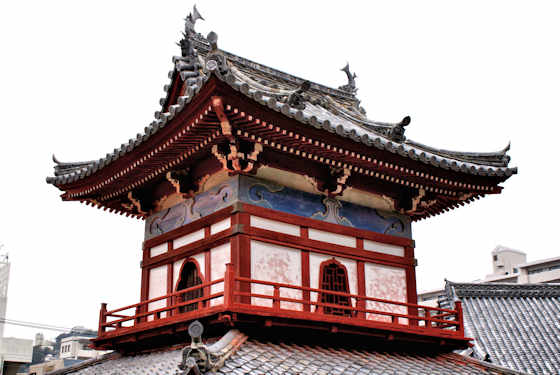Kofukuji was the first of the four"Chinese" temples built in Nagasaki.
The Sanmon, main gate, is the largest temple gate in Nagasaki and was rebuilt in Japanese style in 1690 following the destruction by fire of the original Chinese style gate built in 1654, when the Chinese Zen master known in Japan as Ingen was in residence.
The main hall, Daio Hoden, was originally built in 1632 and then rebuilt in 1689 following the fire . It was damaged by a storm in 1865 and then rebuilt in its current form in 1883. Chinese in style, all the wood was prepared in China and shipped to Nagasaki.
The Sanko Kaisha Gate is all that remains of a compound built within the temple grounds for Chinese from the three SE provinces and included lodgings and meeting halls. All except the gate were severely damaged by the atom bomb blast and subsequently demolished.
Kofukuji was established as a Buddhist temple in 1623 toffer funerals and memorial services to the resident Chinese and also possibly to affirm to the authorities that the Chinese were not in any way Christian.
The Honzon enshrined in the main hall is the historical Buddha, known as Shaka Nyorai in Japanese and Daio in Chinese.
The temple expanded greatly after the arrival and residence of the Chinese monk Yin Yuan, known as Ingen in Japanese. He brought the latest zen teachings and later founded Manpukuji Temple in Kyoto and subsequently the Obaku sect. Kofukuji then became an Obaku temple.
The Maso Do, or Mazu Hall, dates back to 1670 replacing the original that was destroyed by fire. A shrine to Mazu, a seafaring goddess carried on all Chinese ships, was the origin of Kofukuji Temple. The building is completely Chinese in style with many specifically Obaku features.
The gyoban is a wooden fish that is struck like a bell to call monks to meals and is found at many zen temples. The one here at Kofukuji is quite magnificent.
The Maso -do is mostly Japanese architecturally, though some features are obaku.
The belfry is also jaanese in style. The bell was "donated" to the war effort, like many temple bells, in the 1940's

































































